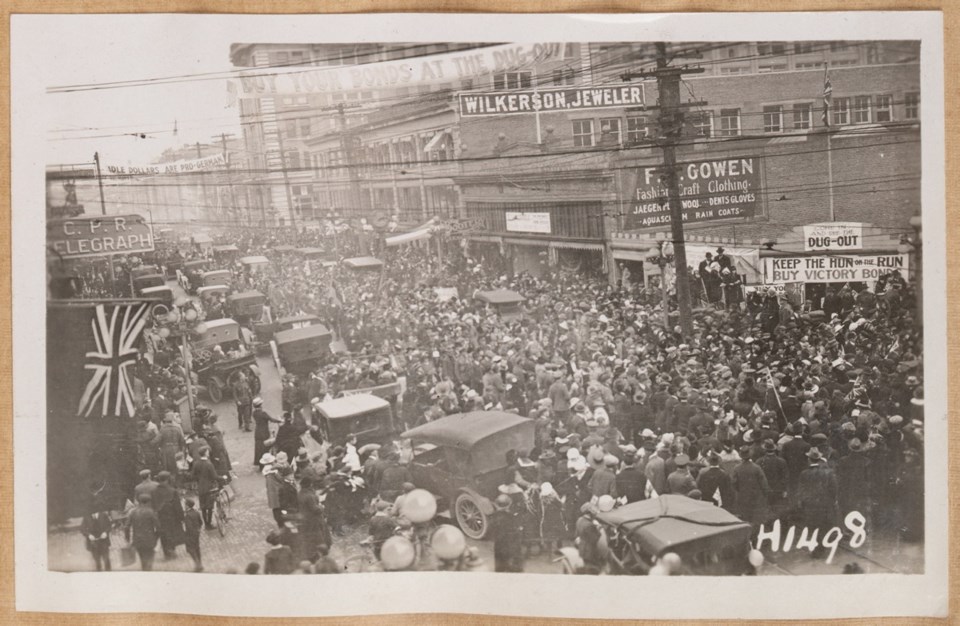One hundred years ago, Victorians spilled onto the streets in reaction to a mistaken telegraph report that the war in Europe was over.
Now called “The False Armistice,” the spontaneous celebration on Nov. 7, 1918, spread from New York to Montreal, then flashed across Canada and around the world.
Victoria’s Daily Colonist in its Nov. 8, 1918, issue reported: “The consequent celebration, which originated with a rumour subsequently proved incorrect coupled with all the noisy attributes of a real celebration excelled anything hitherto experienced in the city.”
The real Armistice Day was Nov. 11, 1918, when the combatants agreed to cease hostilities at 11 a.m. The source of the premature false armistice was traced to American officers who misconstrued the words of a German army delegation.
In Victoria, the Daily Colonist story said the Nov. 7 report of peace arrived about 10 a.m. Ships and boats began blowing whistles and ringing bells. Telephone circuits lit up, and downtown offices emptied.
Workers downed tools despite efforts by their foremen to keep them on the job, the story said.
Then-premier John Oliver said the news should make the day a public holiday. Government offices subsequently emptied of employees. Fireworks, singing and parades of the local regiments were underway by the afternoon.
Don Bourdon, curator of images at the Royal B.C. Museum, said it was a time when Victoria was near desperate for good news, and not just because of the war.
The Spanish flu epidemic had just reached Victoria. To stop its spread, public health officials banned indoor gatherings. Schools closed, theatre performances were cancelled and indoor church services were banned.
The drowned bodies of the roughly 350 people who died on Oct. 25, 2018, when the Canadian Pacific coastal liner SS Princess Sophia struck a reef near Juneau, Alaska, had been surfacing for weeks.
The SS Princess Alice, another CP coastal liner, was near landing in Vancouver with about 70 of the bodies. News reports called the vessel “The Ship of Sorrow.”
All this, amidst a daily diet of notices of men dying in France, fighting as members of the Canadian Expeditionary Force.
“It must have been agonizing to sit here and read the newspapers every day and read these reports of people killed or missing in action,” said Bourdon.
He noted the final 100 days of the war are often celebrated in historical memory as a military triumph. Canadian soldiers in many ways were leading the way, and casualty reports reflected that.
In just the last two days of the war, 280 Canadians were killed.
“They were making really good progress and Canadians were feeling pretty confident,” said Bourdon. “But at the same time, people everywhere must have been really exhausted.”
Historian Jim Kempling, PhD candidate at the University of Victoria and project manager of A City Goes to War, an online resource chronicling Victoria’s experiences of the First World War, said the city was desperate for good news.
Early on, Victoria had enthusiastically responded to the war with volunteer soldiers. Vancouver Island reserve units, including the Canadian Scottish and the Fifth (British Columbia) Field Artillery Regiment can trace their regimental histories to the First World War.
Victoria also responded to the casualties and by November 1918 it was home to six military hospitals.
In those last days of the war, Victoria newspapers were filled with stories of armistice talks. Only a small spark was needed to ignite the party.
There was no prohibition against assembling in the streets, so people took to the streets.
The Daily Colonist noted despite the “arid” no-alcohol conditions imposed by prohibition (in B.C. 1917-1921) “there was evidence of an oasis or two having been located by a considerable number of celebrants.”
“And the population with one accord and superabundant amount of energy and enthusiasm ‘cut loose,’ ” reported the newspaper. “From the premier down to the least important individual, the population rejoiced.”
“Maybe, strictly speaking, the celebration was a bit premature,” reported the story. “But it has been a long time since Victorians felt justified, amid the strife, stress and tragedy of the world war to ‘let go.’ ”
To learn more about the false armistice, watch This Week in History on CHEK News at 5 p.m. Saturday.
The Daily Colonist is available online for free in a partnership between the Times Colonist and the University of Victoria. The site can be searched by date and its pages called up for reading. Go to britishcolonist.ca.
> For more on the 100th anniversary of the end of the war, go to timescolonist.com/more
> In this week's Islander section: More on Victoria and the First World War, 100 years after the armistice



